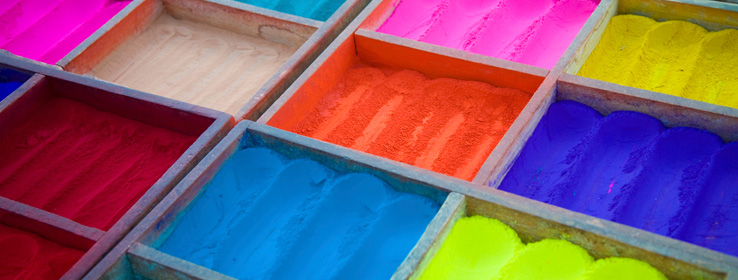India celebrates the arrival of spring in living color
"A day filled with luster and gaiety, a day to smear our dreams with a splash of vibrant, frenzied colors. Holi Hai! A spring of unbounded fun and frolic!" - from the poem "Happy Holi"
Hallelujah! It's finally spring - time to ditch those dark, drab winter woolens and break out the Crayola-bright spring wardrobe.
And in India and Nepal, it's also time to smear friends and neighbors with color - until they look as bright and festive as the season itself.
The Hindu faith has many quiet, solemn rites and rituals. But Holi, the spring Festival of Colors, is anything but. Celebrated at the end of winter, on the last full moon day of the lunar month (usually in March), Holi is about unfettered joy and exuberant frolic.
Standards of polite behavior are relaxed. The rigid structures that separate ages, genders and social castes are loosened. Holi is a time to revel in the beauty of spring - a time for bonfires, playful pranks, and pelting others with colored powder and water.
When Ram Krishnan was a child growing up in India, "Holi was associated with all the silly things - throwing colors at each other, filling water pistols with colors," he says.
Red was the dominant Holi hue. "You'd see people walking around, powder in hand," he recalls. "Sometimes you'd ask permission" before throwing powder at those you'd meet. "If you wanted to be gentle, you'd put some on their forehead. If you wanted to be crazy, you'd throw it on their whole body." But Holi isn't just about pranks and red powder, he notes. The holiday also has ancient religious significance in Hinduism.
For some, Holi celebrates the divine love of Lord Krishna and Radna. For others, Holi celebrates Kamedeva, the Hindu god of love.
Krishnan, who has lived in Minnesota for four decades, now appreciates Holi primarily as an agricultural celebration. To me, it is a harvest festival - the beginning of the harvest season, he says.
Color and culture
In India, immersion in color goes much deeper than a single tradition or a once-a-year festival. Vibrant hues are part of the culture's DNA.
"India's people believe that bright colors are synonymous with life, joy and positive energy," according to the color and design blog Colour Lovers (www.colourlovers.com). "Holi is a day to celebrate these concepts."
According to Colour Lovers, different regions of India have customized the Holi celebration in their own unique way. In some regions, people give each other boxes of sweets or brightly colored flowers. In others, youngsters pay respect to their elders by sprinkling colors on their feet.
The Holi tradition of smearing people with colors grew out of its supposed medicinal benefits. The spring season, when the weather changes, was believed to cause fever and colds. The colors used to celebrate Holi were originally derived from the blossoms of spring trees and from herbs prescribed by Ayurvedic doctors.
But over the years, the colors of Holi have taken a very different direction. As spring-blossoming trees became scarcer, and the celebration itself became more commercial, the natural colorants came to be replaced by industrial dyes, many containing toxic chemicals that have been linked to asthma, skin diseases, eye irritation and temporary blindness. With Holi colors sold loosely by roadside vendors, it was difficult to know what chemicals were going into those festive powders.
In recent years, several organizations have worked to improve Holi safety, teaching children how to make their own Holi colors using natural resources. Some commercial companies, such as the National Botanical Research Institute, have begun to market herbal dyes, so that celebrants can enjoy Holi's colorful traditions without health risk.
In the U.S., Indian communities continue to celebrate Holi, Krishnan says, although "it's mostly a non-religious holiday these days. Typically, it's a time for fun - for dancing, music, food and fireworks." Indian children in the U.S. love Holi, just as Krishnan did when he was a child growing up in India. "Young kids don't know why they're having fun," he says. "They just are."
Holi in pop culture
You don't have to visit India in the springtime to get a glimpse of Holi. The colorful celebration has popped up repeatedly in Western pop culture.
Several music videos have borrowed Holi imagery of people throwing colored powder, including Linkin Park's video for "The Catalyst," Ke$ha's "Take It Off," Scooter's "Behind the Cow," and Regina Spektor's "Fidelity."
Holi has also made cameos in a handful of American movies and TV shows. The 2007 indie film Outsourced tells the story of an American call-center salesman assigned to go to India to train his replacement. There he discovers that to successfully train the new workers, he must first learn about their culture. The catalyst for his change in attitude: a Holi celebration. Outsourced became a TV series in 2011, and the episode "Todd's Holi War" marked Holi's first appearance on American network TV.
The Holi festival was featured as a RoadBlock challenge in the reality show The Amazing Race, while the cable TV show Bollywood Homicide also included an episode that climaxed at a color festival. And TV political talker Keith Olbermann shows clips from Holi festivals on the "Time Marches On" portion of his nightly news show Countdown on The Current.





